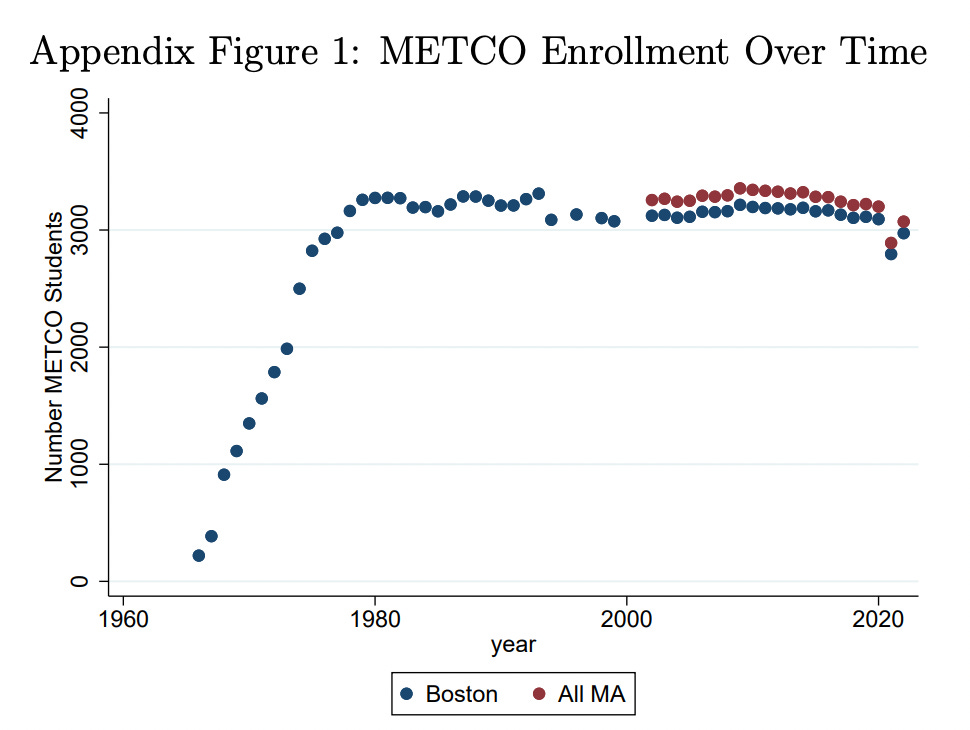Expand popular, successful school choice programs
The Boston METCO program is extremely successful, so why is it stuck at 1980 levels?
In my last piece about expanding high-quality public school choice options, I mentioned the Boston METCO program.
What is METCO? There are three things you need to know about it. The first is the program’s history. Here’s Tufts University professor Elizabeth Setren describing it in a paper for the National Bureau of Economic Research:
One of the longest-running school integration programs in the country, the Metropolitan Council for Educational Opportunity (METCO), has bussed students of color from Boston, Massachusetts to over 33 predominantly White and relatively wealthier suburban school districts since 1966. The program is voluntary for both urban students and suburban districts. Districts decided to accept METCO students during the first decade of the program. METCO gives students the option to enroll in high performing suburban public schools that have substantially higher graduation rates, college-going rates, advanced courses, and student test scores. The program is very popular: 50 percent of Black youth in Boston applied and 20 percent of Latinx youth in the past 20 years.
The second thing you need to know about METCO is that it has a strong track record of effectiveness and family interest. Not only has it made a dent in the city’s racially segregated schools, here’s The 74’s Kevin Mahnken describing Setren’s research on its academic effects:
In all, Setren found, METCO students scored considerably higher on state tests, drawing 49 percent closer to the Massachusetts average in English than their peers by the third grade. They were only two-thirds as likely as their BPS peers to be suspended, and they accrued between three and nine fewer absences each year, in spite of the transportation hassle and time crunch of getting to school miles away from their own neighborhoods.
Things only got better from there: Making the trip to a suburban school raised children’s rate of graduating from high school on time from 79 to 92 percent, while lowering their chance of dropout from 4 to just 1 percent. Participants’ chances of scoring at least 1000 on the SAT were nearly nine points higher, while their chances of scoring 1200 or above were two points higher. They were 21 percentage points more likely to enroll in college and 12 points more likely to graduate.
Perhaps most striking of all is the impact farthest removed from the K–12 years. For those who work in Massachusetts, METCO students earn, on average, $7,708 more annually by the age of 25 than those who never received an offer. Ten years later, that gap grows to an average of $16,250.
And the third thing you need to know is that METCO stopped growing about 45 years ago. Setren was able to track down records for 60,000 applicants over the years, but less than half of those were given offers to attend a school of their choice. And as you can see in the chart below from Setren’s appendix, METCO has essentially been capped since the late 1970s:

This is a shame. A smart Massachusetts politician should be looking at the consistent demand for the METCO program, see the strong results it has demonstrated, and then try to help it grow.
I don’t claim to be an expert on the finer workings of METCO, what explains why it stopped growing 45 years ago, or what it would take to convince more districts to serve more Boston kids, but some enterprising state leader should try to find the answers to those questions, and policymakers in other states should try to figure out how to bring a similar program to their communities.



Very interesting! Curious — how much of this is selection bias? As in, parents whose kids apply and kids who follow through are generally already more conscientious/engaged, and that explains the difference? (Charters’ results are often faulted for this same phenomenon). Echoing Edward below, I’d love to know what makes this work.
Question: Why, specifically, is this program successful?